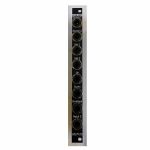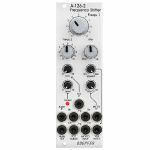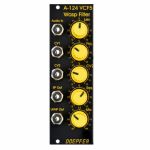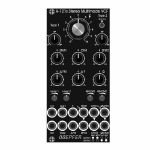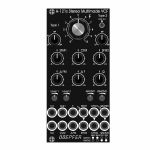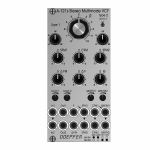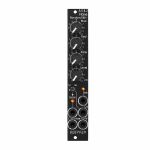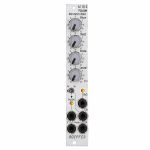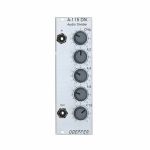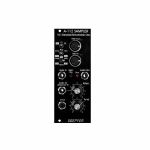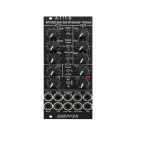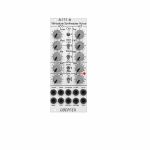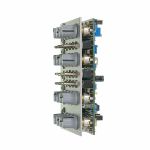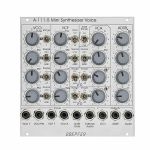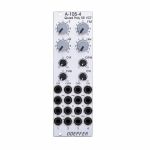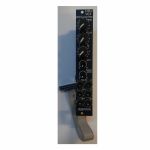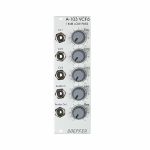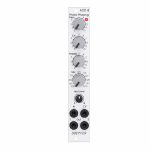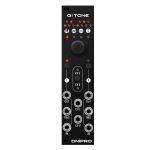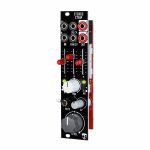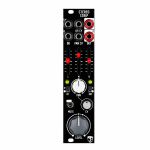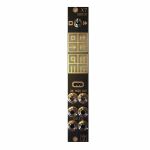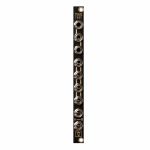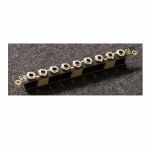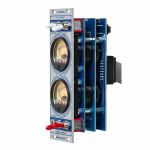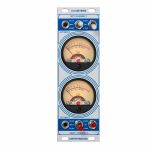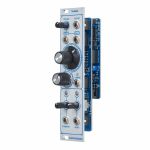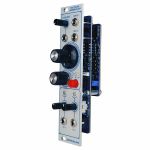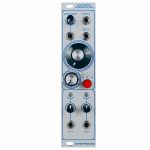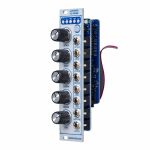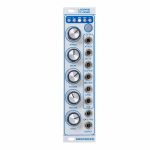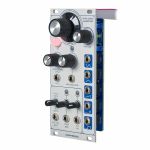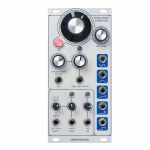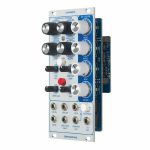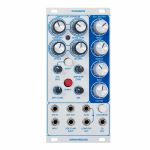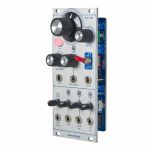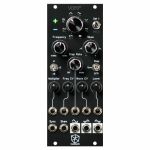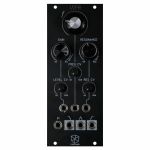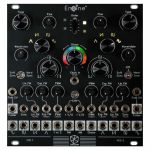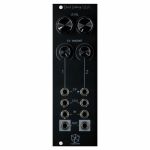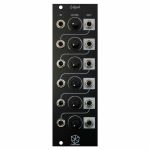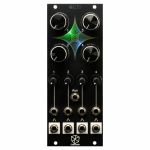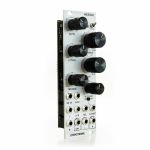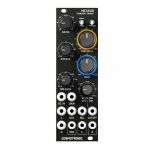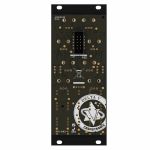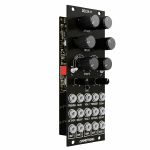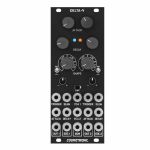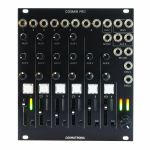Studio equipment
Our full range of studio equipment from all the leading equipment and software brands. Guaranteed fast delivery and low prices.
DJ equipment
Our full range of DJ equipment from all the leading equipment and software brands. Guaranteed fast delivery and low prices. Visit Juno DJ
Filter
Coming Soon
Equipment
Format
Release Date
Featured
Price
Tags
It adds two outputs from the Dome filter (+45 and -45 degrees) as well as separate outputs from the ring modulators 1 and 2, and from the internal envelope generator. Furthermore, it offers dedicated outputs for Up and Down Shift, allowing the module to be patched in stereo.
*Note: The expander can only be used in conjunction with the module A-126-2.
HP : 2
quote 852807
It adds two outputs from the Dome filter (+45 and -45 degrees) as well as separate outputs from the ring modulators 1 and 2, and from the internal envelope generator. Furthermore, it offers dedicated outputs for Up and Down Shift, allowing the module to be patched in stereo.
*Note: The expander can only be used in conjunction with the module A-126-2.
HP : 2
quote 852803
The frequency range of the internal quadrature VCO is about 8 octaves (about 20Hz ... 5kHz). If required an external quadrature VCO can be used.
The module is equipped with these controls, inputs and outputs:
Frequ. 1: first manual control of the shifting frequency (factory setting: coarse, range about 20Hz - 5 kHz)
Frequ. 2: second manual control of the shifting frequency (factory setting: fine)
by means of internal jumpers the sensitivity of Frequ.1 and 2 can be swapped (i.e. Frequ.1 = fine and Frequ.2 = coarse)
the relation between coarse and fine control is about 25:1 (corresponding to about 8 octaves to 1/3 octave)
FCV In (socket) and FCV (small control without knob): control voltage input with attenuator for the external voltage control of the shifting frequency
Mix: manual control of the up/down shift panning unit, fully CCW = down shift, fully CW = up shift, in between a mixture of down and up
Mix CV In (socket) and Mix CV (small control without knob): control voltage input with attenuator for the mixing unit for external voltage control of the up/down mixing
Audio In (socket), Level (small control without knob) and Overload (LED): audio input with attenuator, typ. audio in level = 1Vpp, the level control has to be adjusted so that the overload LED just begins to light up a bit, when the LED is fully on clipping/distortion occurs, when the LED is permanently off the input level is too low and the signal-to-noise ratio increases
Audio Out (socket): audio output of the frequency shifter
Squelch (small control without knob): controls the squelch function: fully CCW (Env.) the output VCA is controlled by the envelope signal, which is derived from the audio input signal, fully CW (open) the output VCA is permanently open (no squelch function), in between the squelch intensity can be adjusted
Quadrature VCO Outputs (sockets Sin and Cos): outputs of the internal quadrature oscillator, about 12Vpp level (+6V/-6V)
Ext. Inputs Sin and Cos (sockets): required when an external quadrature VCO (e.g. A-143-9 with a wider frequency range or A-110-4 with thru zero feature or A-110-6 with different waveforms) is used instead of the internal quadrature VCO, the levels of the external VCO should be about 10Vpp (8...10Vpp are OK) and the signals have to be symmetrical around zero Volts, the sockets are normalled to the internal quadrature VCO (i.e. the sockets are equipped with switching contacts that interrupt the internal connection as soon as a plug inserted)
VCA ext. CV (socket): used when an external control voltage (e.g. from an envelope generator) should be used to control the output VCA instead of the internal squelch unit, the socket is normalled to the output of the squelch control (i.e. the socket is equipped with a switching contact that interrupts the internal squelch connection as soon as a plug inserted). From about +8V external control voltage the VCA is fully open.
Internal terminals (pin headers, e.g. for a DIY breakout module):
envelope follower output
dome filter output 1
dome filter output 2
ring modulator 1 output
ring modulator 2 output
Up shift output
Down shift output
quote 847081
Inputs: Audio In, CV In (2x)
Outputs: Bandpass Out, Low/Highpass Mix-Out
Controls: Audio and CV attenuator, Frequency, Resonance, LP/HP Mix
The function and operation of this module is very similar to the module SEM VCF A-106-5. But the sound of both filters is very different! The only functional difference is the position of the sockets and controls, and the function of the controls CV2 (A-124: normal attenuator, A-106-5: polarizer).
- 3U Eurorack module, 8HP wide, 45mm deep
- Current draw 30mA
8 in stock $78.24
quote 671564
Module A-121s is a dual multimode filter which can be used for stereo applications as well as for parallel or serial organized dual mono filters. The core is a 12dB multimode filter identical to the modules A-121-2 and A-121-3. The selection of the filter type is continuously from lowpass via notch and highpass to bandpass. We attached great importance to the usability of the manual controls and CV inputs for both stereo and dual mono applications. For the filter parameters frequency (F), resonance (Q) and type (T) common controls and CV inputs as well as single controls and CV inputs are available. For the filter frequency in addition a manual control and CV input for the filter spread (frequency difference or delta F) is available.
Controls:
F: master frequency control for both filters (large knob)
Type 1 / Type 2: filter type panning/morphing L-N-H-B
Link to 1: Toggle switch so that Type 1 also controls type of filter 2 (i.e. simultaneous filter type control for both filters)
SFM1 / SFM2: Single Frequency Modulation controls (polarizers), connected to the corresponding sockets SFM1/SFM2 (socket SFM1 is normalled to a fixed positive voltage, SFM2 is normalled to SFM1, that way the controls SFM1/SFM2 work as frequency controls for each filter provided that no modulation signals are patched to the SFM1/SFM2 sockets)
CFM: common frequency control, controls two VC-polarizers which process the signals connected to the two sockets CFM1/CFM2, CFM2 is normalled to CFM1, that way also the same modulation signal (e.g. an envelope generator) can be used for both filters and the level controlled simultaneously by the CFM control
Delta F: controls the difference between the frequencies of the two filters manually (frequency "spread"), at centre position the frequencies are the same
Delta FM: controls the level of the Delta FM signal (socket), which allows to control the spread between the frequencies also by an external control voltage (e.g. by an LFO or ADSR)
Q: controls the resonance of both filters simultaneously
Level 1 / Level 2: attenuators for the two audio inputs
QM/TM1, QM/TM2: attenuators for the modulation inputs QM/TM1 and QM/TM2
Sockets:
In1 / In2: audio inputs (In2 is normalled to In1)
Out1 / Out2: audio outputs
F: common frequency control input for both filters (~ 1V/oct)
Delta FM: Control voltage for frequency spread, processed by the polarizer Delta FM
SFM1 / SFM2: single frequency modulation inputs, processed by the polarizers SFM1 and SFM2, SFM1 is normalled to a fixed positive voltage, SFM2 is normalled to SFM1#
CFM1 / CFM2: common frequency modulation inputs, processed by the two voltage controlled polarizers controlled by CFM knob, CFM2 is normalled to CFM1
QM/TM1, QM/TM2: the addressing of these sockets/attenuators is defined by internal jumpers. QM means Q modulation (i.e. resonance modulation), TM means filter type modulation (QM1 = resonance modulation filter 1, QM2 = resonance modulation filter 2, TM1 = filter type modulation filter 1, TM2 = filter type modulation filter 2), socket QM/TM1 is normalled to a fixed positive voltage, QM/TM2 is normalled to QM/TM1
A 45 degrees triangle next to a socket means that the switching contact of the socket is normalled to a fixed positive voltage (SFM1, QM/TM1).
A vertical triangle indicates the normalling of two sockets (In1>In2, SFM1>SFM2, CFM1>CFM2, QM/TM1>QM/TM2).
If the filters do not behave as expected please pay attention to these peculiarities:
For the controls SFM1, SFM2, CFM, Delta F and Delta FM the centre position is the neutral position as these are polarizers. If the filter behaves unexpected these controls should be set to centre positions for the time being.
For the controls F, Q, Level 1, Level 2, QM/TM1 und QM/TM2 the fully CCW position is the neutral position as these are standard attenuators. If the filter behaves unexpected at least the controls QM/TM1 and QM/TM2 should be set to fully CCW. Via the normalling of the sockets QM/TM1 and QM/TM2 and the associated controls the filter parameters adjusted by the major controls (e.g. Type 1, Type 2 or Q) may be overwritten.
By means of small circles at the bottom right side of the front panel the user can mark the function of the QM/TM inputs. These assignments are possible:
QM/TM1 controls QM1, QM/TM2 controls QM2, the filter types are not controlled by external CVs
QM/TM1 controls TM1, QM/TM2 controls TM2, the resonances are not controlled by external CVs
QM/TM1 controls QM1 and QM2 simultaneously, QM/TM2 controls TM1 and TM2 simultaneously
Controls:
F: master frequency control for both filters (large knob)
Type 1 / Type 2: filter type panning/morphing L-N-H-B
Link to 1: Toggle switch so that Type 1 also controls type of filter 2 (i.e. simultaneous filter type control for both filters)
SFM1 / SFM2: Single Frequency Modulation controls (polarizers), connected to the corresponding sockets SFM1/SFM2 (socket SFM1 is normalled to a fixed positive voltage, SFM2 is normalled to SFM1, that way the controls SFM1/SFM2 work as frequency controls for each filter provided that no modulation signals are patched to the SFM1/SFM2 sockets)
CFM: common frequency control, controls two VC-polarizers which process the signals connected to the two sockets CFM1/CFM2, CFM2 is normalled to CFM1, that way also the same modulation signal (e.g. an envelope generator) can be used for both filters and the level controlled simultaneously by the CFM control
Delta F: controls the difference between the frequencies of the two filters manually (frequency "spread"), at centre position the frequencies are the same
Delta FM: controls the level of the Delta FM signal (socket), which allows to control the spread between the frequencies also by an external control voltage (e.g. by an LFO or ADSR)
Q: controls the resonance of both filters simultaneously
Level 1 / Level 2: attenuators for the two audio inputs
QM/TM1, QM/TM2: attenuators for the modulation inputs QM/TM1 and QM/TM2
Sockets:
In1 / In2: audio inputs (In2 is normalled to In1)
Out1 / Out2: audio outputs
F: common frequency control input for both filters (~ 1V/oct)
Delta FM: Control voltage for frequency spread, processed by the polarizer Delta FM
SFM1 / SFM2: single frequency modulation inputs, processed by the polarizers SFM1 and SFM2, SFM1 is normalled to a fixed positive voltage, SFM2 is normalled to SFM1#
CFM1 / CFM2: common frequency modulation inputs, processed by the two voltage controlled polarizers controlled by CFM knob, CFM2 is normalled to CFM1
QM/TM1, QM/TM2: the addressing of these sockets/attenuators is defined by internal jumpers. QM means Q modulation (i.e. resonance modulation), TM means filter type modulation (QM1 = resonance modulation filter 1, QM2 = resonance modulation filter 2, TM1 = filter type modulation filter 1, TM2 = filter type modulation filter 2), socket QM/TM1 is normalled to a fixed positive voltage, QM/TM2 is normalled to QM/TM1
A 45 degrees triangle next to a socket means that the switching contact of the socket is normalled to a fixed positive voltage (SFM1, QM/TM1).
A vertical triangle indicates the normalling of two sockets (In1>In2, SFM1>SFM2, CFM1>CFM2, QM/TM1>QM/TM2).
If the filters do not behave as expected please pay attention to these peculiarities:
For the controls SFM1, SFM2, CFM, Delta F and Delta FM the centre position is the neutral position as these are polarizers. If the filter behaves unexpected these controls should be set to centre positions for the time being.
For the controls F, Q, Level 1, Level 2, QM/TM1 und QM/TM2 the fully CCW position is the neutral position as these are standard attenuators. If the filter behaves unexpected at least the controls QM/TM1 and QM/TM2 should be set to fully CCW. Via the normalling of the sockets QM/TM1 and QM/TM2 and the associated controls the filter parameters adjusted by the major controls (e.g. Type 1, Type 2 or Q) may be overwritten.
By means of small circles at the bottom right side of the front panel the user can mark the function of the QM/TM inputs. These assignments are possible:
QM/TM1 controls QM1, QM/TM2 controls QM2, the filter types are not controlled by external CVs
QM/TM1 controls TM1, QM/TM2 controls TM2, the resonances are not controlled by external CVs
QM/TM1 controls QM1 and QM2 simultaneously, QM/TM2 controls TM1 and TM2 simultaneously
Controls:
F: master frequency control for both filters (large knob)
Type 1 / Type 2: filter type panning/morphing L-N-H-B
Link to 1: Toggle switch so that Type 1 also controls type of filter 2 (i.e. simultaneous filter type control for both filters)
SFM1 / SFM2: Single Frequency Modulation controls (polarizers), connected to the corresponding sockets SFM1/SFM2 (socket SFM1 is normalled to a fixed positive voltage, SFM2 is normalled to SFM1, that way the controls SFM1/SFM2 work as frequency controls for each filter provided that no modulation signals are patched to the SFM1/SFM2 sockets)
CFM: common frequency control, controls two VC-polarizers which process the signals connected to the two sockets CFM1/CFM2, CFM2 is normalled to CFM1, that way also the same modulation signal (e.g. an envelope generator) can be used for both filters and the level controlled simultaneously by the CFM control
Delta F: controls the difference between the frequencies of the two filters manually (frequency "spread"), at centre position the frequencies are the same
Delta FM: controls the level of the Delta FM signal (socket), which allows to control the spread between the frequencies also by an external control voltage (e.g. by an LFO or ADSR)
Q: controls the resonance of both filters simultaneously
Level 1 / Level 2: attenuators for the two audio inputs
QM/TM1, QM/TM2: attenuators for the modulation inputs QM/TM1 and QM/TM2
Sockets:
In1 / In2: audio inputs (In2 is normalled to In1)
Out1 / Out2: audio outputs
F: common frequency control input for both filters (~ 1V/oct)
Delta FM: Control voltage for frequency spread, processed by the polarizer Delta FM
SFM1 / SFM2: single frequency modulation inputs, processed by the polarizers SFM1 and SFM2, SFM1 is normalled to a fixed positive voltage, SFM2 is normalled to SFM1#
CFM1 / CFM2: common frequency modulation inputs, processed by the two voltage controlled polarizers controlled by CFM knob, CFM2 is normalled to CFM1
QM/TM1, QM/TM2: the addressing of these sockets/attenuators is defined by internal jumpers. QM means Q modulation (i.e. resonance modulation), TM means filter type modulation (QM1 = resonance modulation filter 1, QM2 = resonance modulation filter 2, TM1 = filter type modulation filter 1, TM2 = filter type modulation filter 2), socket QM/TM1 is normalled to a fixed positive voltage, QM/TM2 is normalled to QM/TM1
A 45 degrees triangle next to a socket means that the switching contact of the socket is normalled to a fixed positive voltage (SFM1, QM/TM1).
A vertical triangle indicates the normalling of two sockets (In1>In2, SFM1>SFM2, CFM1>CFM2, QM/TM1>QM/TM2).
If the filters do not behave as expected please pay attention to these peculiarities:
For the controls SFM1, SFM2, CFM, Delta F and Delta FM the centre position is the neutral position as these are polarizers. If the filter behaves unexpected these controls should be set to centre positions for the time being.
For the controls F, Q, Level 1, Level 2, QM/TM1 und QM/TM2 the fully CCW position is the neutral position as these are standard attenuators. If the filter behaves unexpected at least the controls QM/TM1 and QM/TM2 should be set to fully CCW. Via the normalling of the sockets QM/TM1 and QM/TM2 and the associated controls the filter parameters adjusted by the major controls (e.g. Type 1, Type 2 or Q) may be overwritten.
By means of small circles at the bottom right side of the front panel the user can mark the function of the QM/TM inputs. These assignments are possible:
QM/TM1 controls QM1, QM/TM2 controls QM2, the filter types are not controlled by external CVs
QM/TM1 controls TM1, QM/TM2 controls TM2, the resonances are not controlled by external CVs
QM/TM1 controls QM1 and QM2 simultaneously, QM/TM2 controls TM1 and TM2 simultaneously
Depth: 45mm
HP : 12
The pre-amp has two inputs: an unbalanced input for line level signals, with a gain factor of from 0 to 20, and a balanced input with a gain factor of from 0 to 500, for insertion of low level signals, for instance from a microphone or electric guitar.
The Envelope Follower reads the signal level of the input, and puts out a proportional voltage as an envelope at its own output.
The comparator generates a gate signal whenever the input goes above an adjustable trigger threshold.
Three LED's help you keep track of overload, the envelope, and the gate signal.
quote 577771
The noise signal is generated 100% analog by amplification of the noise of a transistor. White and colored noise are usually used as audio sources. The random voltages are normally used as control voltages (e.g. for filter frequency or any other voltage controlled parameter).
The A-118-2 gives you the ability to mix the relative amounts of Red and Blue noise (low/high frequency component) in the colored noise output.
For the continuous random voltage the rate of change (Rate) and amplitude (Level) of the random voltage can be adjusted. The continuous random voltage is used as source for the S&H/T&H unit. The type of operation can be set to S&H (sample and hold) or T&H (track and hold). When T&H is chosen the output signal follows the input signal as long as the Clock input is "high". As soon as the clock signal changes to "low" the last voltage is stored. When S&H is chosen the input signal is sampled at the rising edge of the Clock signal. For the Clock signal a "digital" signal (e.g. Clock, Gate, rectangle output of an LFO) is required. Dual color LEDs are used to indicates the continuous and stepped random voltages.
Controls:
Blue: share of the high frequencies in the the colored noise output
Red: share of the low frequencies in the the colored noise output
Rate: rate of change of the continuous random voltage
Level: amplitude of the continuous random voltage
TH/SH: switches between T&H und S&H
Inputs and outputs:
RND: continuous random voltage output (with LED display)
TH/SH: stepped random voltage output (with LED display)
Clk: Clock input of the S&H/T&H unit
C Noise: colored noise output
W Noise: white noise output
Important notes:
After power on it takes a few minutes until the two noise signals and the random signals are generated. The module is not faulty when after power on the signals do not appear immediately!
The S&H/T&H function is realized by pure analog circuitry (electronic switch followed by a holding capacitor and buffer). Consequently the output voltage drifts a bit in the holding state because the capacitor is discharged by parasitic resistors. The drift depends also upon environmental conditions like humidity or temperature.
The level of the random voltage changes with the settings of the Blue and Red controls. Especially the Red control affects the random voltage level (which is derived by low pass filtering from the colored noise signal) because the Red control changes the share of the low frequencies in the colored noise signal. The effect of the Blue control is much smaller because it changes the share of the high frequencies in the colored noise signal which are filtered out by the low pass of the random circuitry.
Power consumption: 20mA at +12V and 20mA at -12V
Depth: 40mm
HP : 4
The module generates the signals white noise, colored noise, continuous random voltage and stepped random voltage (derived from the continuous random voltage by means of a S&H/T&H unit).
The noise signal is generated 100% analog by amplification of the noise of a transistor. White and colored noise are usually used as audio sources. The random voltages are normally used as control voltages (e.g. for filter frequency or any other voltage controlled parameter).
The A-118-2 gives you the ability to mix the relative amounts of Red (low frequency component) and Blue noise (high frequency component) in the colored noise output.
For the continuous random voltage the rate of change (Rate) and amplitude (Level) of the random voltage can be adjusted. The continuous random voltage is derived from the colored noise signal by low pass filtering. Consequently the settings of the controls for the colored noise (Blue, Red) affect the behavior of the random voltage! A dual color LED (red = positive / yellow = negative output voltage) indicates the continuous random voltage.
The continuous random voltage is used as source for the S&H/T&H unit. The type of operation can be set to S&H (sample and hold) or T&H (track and hold). When T&H is chosen the output signal follows the input signal (= continuous random voltage) as long as the Clock input is "high". As soon as the clock signal changes to "low" the last voltage is stored. When S&H is chosen the input signal (= continuous random voltage) is sampled at the rising edge of the Clock signal.
For the Clock signal a "digital" signal (e.g. Clock, Gate, rectangle output of an LFO) is required. It does not work with slowly changing continuous CV signals. Another dual color LED (red = positive / yellow = negative output voltage) indicates the stepped random voltage.
Controls:
Blue: share of the high frequencies in the the colored noise output
Red: share of the low frequencies in the the colored noise output
Rate: rate of change of the continuous random voltage
Level: amplitude of the continuous random voltage
TH/SH: switches between T&H and S&H
Inputs and outputs:
RND: continuous random voltage output (with LED display)
TH/SH: stepped random voltage output (with LED display)
Clk: Clock input of the S&H/T&H unit
C Noise: colored noise output
W Noise: white noise output
Important notes:
After power on it takes a few minutes until the two noise signals and the random signals are generated. The module is not faulty when after power on the signals do not appear immediately!
The S&H/T&H function is realized by pure analog circuitry (electronic switch followed by a holding capacitor and buffer). Consequently the output voltage drifts a bit in the holding state because the capacitor is discharged by parasitic resistors. The drift depends also upon environmental conditions like humidity or temperature.
Dimensions
4 HP
40 mm deep
Current Draw
20 mA +12V
20 mA -12V
At the output, the A-115 produces a summed mix of the original and the four sub-octaves. There are attenuators to control the amount (i.e. Amplitude) of the original signal and each of the sub-octaves.
Bear in mind that the sub-octaves output by the A-115 are all true square waves. At the output there are always four square waves and the original signal available.
quote 698545
Sampling mode: 8 bit audio resolution, 128kB memory in 2 banks 64kB each (equivalent to 2 seconds of sampling time for each bank with 32 kHz sampling rate), audio input with attenuator, overload display in record mode (gate LED), possibility of MIDI Dump to store sounds in a computer via MIDI, non-volatile memory for the 2 samples in the module, manual tune control for adjustment of sampling rate for record and play, CV input (~ 1V/Oct), both manual tune and CV determine the sampling rate respectively the pitch (pitch range is 5 octaves), gate input (not a trigger: the sample starts at the positive edge of the gate signal and is played as long as gate is high or until the end of the sample is reached), manual Gate button, non-filtered audio output (thus quantizing noise can be used as an element of the sound intentionally).
Wavetable mode: special appearance of the sampling mode when playing a sample, the audio input is now used as a second control voltage input for moving through the sample in 256 byte wide loops (wavetables). The control voltage required to move through all wavetables applied to the input "Wave CV In" is in the range -2.5V (wavetable 1) ... 0V (wavetable 127) ... +2.5V (wavetable 256) when control "Atten." is set fully clockwise. To achieve the typical wavetable oscillator sounds the sampling memory must contain corresponding wavetable data (e.g. loaded via MIDI dump). These data contain a set of wavetables with different harmonic content (e.g. a filter sweep) to get the typical wavetable sound while moving through the tables via CV. But you may also use a "normal" sample and go through the sample with CV to obtain partially amazing sounds never heard before. You may use for example sampled speech and go with CV through the syllables or speech shreds to get really very extreme sounds. An ideal addition for this feature is the Offset/Attenuator module A-183-2 which can be used to adjust the position of the wavetable (Offset) and the modulation depth (Att.). The corresponding jumper of the A-183-2 has to be set to bipolar offset (as the A-112 requires -2.5V...+2.5V to pass through all 256 wavetables). As modulation source an LFO (A-145, A-146, A-147, A-143-3), ADSR (A-140, A-141, A-142, A-143-1/2) or a random voltage (A-118, A-149-1) may be used. Even a ribbon controller (A-198 or R2M), the Theremin module A-178, the Joystick A-174 or the Wheels module A-174-2 are useful to drive through the wavetables.
Effects: Additionally, the module offers - in a way free of charge - some effects like delay, reverse delay, pitch shifting or freeze. But it has to be pointed out that due to the 8 bit audio resolution these effects are not comparable to high quality effect units and should be understand as an extra for nothing. The A-112 is not an effects unit!
The sampling time of the A-112 is about 1...30 seconds corresponding to a sampling frequency range of about 60kHz...2kHz (64kB@60kHz ~ 1 s, 64kB@2kHz ~ 30 s).
Technical note: the module uses a battery for the non-volatile storage of the sampling data. Batteries have a limited lifespan and have to be inspected at least every two years. For details please refer to the FAQ page of our website: Lifespan of rechargeable batteries (used for memory backup).
quote 671610
VCO:
- Tune: manual tune control (with an internal jumper the range can be set to ~ +/-1 half an octave or ~ +/-2.5 octaves)
- Oct: range switch -1 / 0 / +1 octave
- Mod: modulation depth (attenuator wired to the Mod. socket)
- Dest: switch that is used to address the modulation to frequency modulation (position FM) or pulsewidth modulation (positon PM), in centre positon no modulation
- PW: manual pulsewidth control for rectangle waveform, PW can be also modulated by the Mod. input as mentioned above
- Wave: waveform switch (sawtooth / off / triangle), the sum of the waveform chosen by this switch and the rectangle is fed into the VCF (to turn the rectangle off the PW control has to be set fully CCW or fully CW)
- 1V/Oct. (socket): external CV input for VCO frequency (1V/octave)
- Access to internal bus CV (via jumper, optional, please remove the bus jumper if this feature is not used to avoid unwanted frequency modulation as then the unused CV line of the bus works as a kind of antenna)
- Triangle core VCO, frequency range about 32Hz ... 8kHz
Balance unit:
- The balance unit is made of two VCAs which are controlled by the sum of manual Balance control and the balance CV input in the opposite direction.
- The audio input of VCA1 is hard-wired to the VCO output, audio input 2 is connected to the socket Ext.In.
- The output of the balance unit is used as audio input for the VCF
- Bal.: manual balance control, fully CCW the internal VCO is used, fully CW the external signal (Ext.In) is used, at centre position both signals have about the same level
- CV Bal.: CV input for balance (range about 0...+5V)
- Ext. In: external audio input for VCA2, about 5 Vpp level required for similar loudness as the internal VCO
- This socket is normalled to the internal VCO suboctave f/2 signal (rectangle with half the frequency), if no external signal is applied the suboctave signal is used as the second signal for the balance unit
VCF:
- 24 dB low pass
- Frq: manual frequency control
- FM1: frequency modulation depth (attenuator wired to the VCF FM1 socket, the socket is normalled to the internal Envelope signal and then FM1 controls the modulation depth of the internal envelope applied to the filter)
- FM2 (socket) : second CV input for VCF without attenuator (about 1V/octave), can be used e.g. for VCF tracking by connecting the same CV which is used also for the VCO frequency
- Res: manual resonance control (up to self oscillation)
- If the VCO is turned off (waveform switch = centre position, pulsewidth control = fully CCW or CW) and the VCF resonance is set to maximum the module can be used as a sine oscillator, the tracking at socket VCF FM2 is about 1V/octave (not as precise as the VCO but much better than most other filters)
- ~ 11 octaves frequency range (~ 10 Hz ... 20kHz)
VCA:
- Gain: manual amplitude control (initial gain), can be used to open the VCA without envelope signal
- VCA (switch): used to switch between gate and envelope as control signal for the VCA, in centre position the VCA is not controlled by envelope or gate
- Note: when gate is used the VCA is controlled directly by the gate signal (i.e. hard on/off), this may lead to clicking noise under certain conditions (especially with low VCO/VCF frequencies)
- Special control scale: exponential scale in the range from about -20dB to -80/90dB, linear scale from about -20dB to 0dB
- Remark: this special control scale results in a loudness behaviour that is a bit different from pure linear or exponential VCAs
- Out: audio output of the module (= VCA output)
Envelope:
- Gate (socket): Gate input (min. +5V), can be normalled to the bus gate signal by means of a jumper
- Att: manual control for Attack
- D/R: manual control for Decay/Release
- Env. (switch): used to switch between A/D, ADSR and A/R mode of the envelope generator, in centre position (ADSR) the sustain level is fixed to about 50%
- Envelope (socket): envelope output (about +10V)
- CVT (socket): CV input for time control, by means of two internal jumpers one can select which time parameters are controlled by the CVT input (e.g. A only or D/R only or A/D/R) and in which direction (i.e. if an increasing CVT shortens or stretches the time parameter in question)
- Envelope LED display
- Attack time range: ~ 1ms ... 5 sec (can be extended by using the CVT input)
- Decay/Release time range: ~ 1ms ... 15 sec (can be extended by using the CVT input)
1 in stock $163.70
- Tune: manual tune control (with an internal jumper the range can be set to ~ +/-1 half an octave or ~ +/-2.5 octaves)
- Oct: range switch -1 / 0 / +1 octave
- Mod: modulation depth (attenuator wired to the Mod. socket)
- Dest: switch that is used to address the modulation to frequency modulation (position FM) or pulsewidth modulation (positon PM), in centre positon no modulation
- PW: manual pulsewidth control for rectangle waveform, PW can be also modulated by the Mod. input as mentioned above
- Wave: waveform switch (sawtooth / off / triangle), the sum of the waveform chosen by this switch and the rectangle is fed into the VCF (to turn the rectangle off the PW control has to be set fully CCW or fully CW)
- 1V/Oct. (socket): external CV input for VCO frequency (1V/octave)
- Access to internal bus CV (via jumper, optional, please remove the bus jumper if this feature is not used to avoid unwanted frequency modulation as then the unused CV line of the bus works as a kind of antenna)
- Triangle core VCO, frequency range about 32Hz ... 8kHz
Balance unit:
- The balance unit is made of two VCAs which are controlled by the sum of manual Balance control and the balance CV input in the opposite direction.
- The audio input of VCA1 is hard-wired to the VCO output, audio input 2 is connected to the socket Ext.In.
- The output of the balance unit is used as audio input for the VCF
- Bal.: manual balance control, fully CCW the internal VCO is used, fully CW the external signal (Ext.In) is used, at centre position both signals have about the same level
- CV Bal.: CV input for balance (range about 0...+5V)
- Ext. In: external audio input for VCA2, about 5 Vpp level required for similar loudness as the internal VCO
- This socket is normalled to the internal VCO suboctave f/2 signal (rectangle with half the frequency), if no external signal is applied the suboctave signal is used as the second signal for the balance unit
VCF:
- 24 dB low pass
- Frq: manual frequency control
- FM1: frequency modulation depth (attenuator wired to the VCF FM1 socket, the socket is normalled to the internal Envelope signal and then FM1 controls the modulation depth of the internal envelope applied to the filter)
- FM2 (socket) : second CV input for VCF without attenuator (about 1V/octave), can be used e.g. for VCF tracking by connecting the same CV which is used also for the VCO frequency
- Res: manual resonance control (up to self oscillation)
- If the VCO is turned off (waveform switch = centre position, pulsewidth control = fully CCW or CW) and the VCF resonance is set to maximum the module can be used as a sine oscillator, the tracking at socket VCF FM2 is about 1V/octave (not as precise as the VCO but much better than most other filters)
- ~ 11 octaves frequency range (~ 10 Hz ... 20kHz)
VCA:
- Gain: manual amplitude control (initial gain), can be used to open the VCA without envelope signal
- VCA (switch): used to switch between gate and envelope as control signal for the VCA, in centre position the VCA is not controlled by envelope or gate
- Note: when gate is used the VCA is controlled directly by the gate signal (i.e. hard on/off), this may lead to clicking noise under certain conditions (especially with low VCO/VCF frequencies)
- Special control scale: exponential scale in the range from about -20dB to -80/90dB, linear scale from about -20dB to 0dB
- Remark: this special control scale results in a loudness behaviour that is a bit different from pure linear or exponential VCAs
- Out: audio output of the module (= VCA output)
Envelope:
- Gate (socket): Gate input (min. +5V), can be normalled to the bus gate signal by means of a jumper
- Att: manual control for Attack
- D/R: manual control for Decay/Release
- Env. (switch): used to switch between A/D, ADSR and A/R mode of the envelope generator, in centre position (ADSR) the sustain level is fixed to about 50%
- Envelope (socket): envelope output (about +10V)
- CVT (socket): CV input for time control, by means of two internal jumpers one can select which time parameters are controlled by the CVT input (e.g. A only or D/R only or A/D/R) and in which direction (i.e. if an increasing CVT shortens or stretches the time parameter in question)
- Envelope LED display
- Attack time range: ~ 1ms ... 5 sec (can be extended by using the CVT input)
- Decay/Release time range: ~ 1ms ... 15 sec (can be extended by using the CVT input)
- Tune: manual tune control (with an internal jumper the range can be set to ~ +/-1 half an octave or ~ +/-2.5 octaves)
- Oct: range switch -1 / 0 / +1 octave
- Mod: modulation depth (attenuator wired to the Mod. socket)
- Dest: switch that is used to address the modulation to frequency modulation (position FM) or pulsewidth modulation (positon PM), in centre positon no modulation
- PW: manual pulsewidth control for rectangle waveform, PW can be also modulated by the Mod. input as mentioned above
- Wave: waveform switch (sawtooth / off / triangle), the sum of the waveform chosen by this switch and the rectangle is fed into the VCF (to turn the rectangle off the PW control has to be set fully CCW or fully CW)
- 1V/Oct. (socket): external CV input for VCO frequency (1V/octave)
- Access to internal bus CV (via jumper, optional, please remove the bus jumper if this feature is not used to avoid unwanted frequency modulation as then the unused CV line of the bus works as a kind of antenna)
- Triangle core VCO, frequency range about 32Hz ... 8kHz
Balance unit:
- The balance unit is made of two VCAs which are controlled by the sum of manual Balance control and the balance CV input in the opposite direction.
- The audio input of VCA1 is hard-wired to the VCO output, audio input 2 is connected to the socket Ext.In.
- The output of the balance unit is used as audio input for the VCF
- Bal.: manual balance control, fully CCW the internal VCO is used, fully CW the external signal (Ext.In) is used, at centre position both signals have about the same level
- CV Bal.: CV input for balance (range about 0...+5V)
- Ext. In: external audio input for VCA2, about 5 Vpp level required for similar loudness as the internal VCO
- This socket is normalled to the internal VCO suboctave f/2 signal (rectangle with half the frequency), if no external signal is applied the suboctave signal is used as the second signal for the balance unit
VCF:
- 24 dB low pass
- Frq: manual frequency control
- FM1: frequency modulation depth (attenuator wired to the VCF FM1 socket, the socket is normalled to the internal Envelope signal and then FM1 controls the modulation depth of the internal envelope applied to the filter)
- FM2 (socket) : second CV input for VCF without attenuator (about 1V/octave), can be used e.g. for VCF tracking by connecting the same CV which is used also for the VCO frequency
- Res: manual resonance control (up to self oscillation)
- If the VCO is turned off (waveform switch = centre position, pulsewidth control = fully CCW or CW) and the VCF resonance is set to maximum the module can be used as a sine oscillator, the tracking at socket VCF FM2 is about 1V/octave (not as precise as the VCO but much better than most other filters)
- ~ 11 octaves frequency range (~ 10 Hz ... 20kHz)
VCA:
- Gain: manual amplitude control (initial gain), can be used to open the VCA without envelope signal
- VCA (switch): used to switch between gate and envelope as control signal for the VCA, in centre position the VCA is not controlled by envelope or gate
- Note: when gate is used the VCA is controlled directly by the gate signal (i.e. hard on/off), this may lead to clicking noise under certain conditions (especially with low VCO/VCF frequencies)
- Special control scale: exponential scale in the range from about -20dB to -80/90dB, linear scale from about -20dB to 0dB
- Remark: this special control scale results in a loudness behaviour that is a bit different from pure linear or exponential VCAs
- Out: audio output of the module (= VCA output)
Envelope:
- Gate (socket): Gate input (min. +5V), can be normalled to the bus gate signal by means of a jumper
- Att: manual control for Attack
- D/R: manual control for Decay/Release
- Env. (switch): used to switch between A/D, ADSR and A/R mode of the envelope generator, in centre position (ADSR) the sustain level is fixed to about 50%
- Envelope (socket): envelope output (about +10V)
- CVT (socket): CV input for time control, by means of two internal jumpers one can select which time parameters are controlled by the CVT input (e.g. A only or D/R only or A/D/R) and in which direction (i.e. if an increasing CVT shortens or stretches the time parameter in question)
- Envelope LED display
- Attack time range: ~ 1ms ... 5 sec (can be extended by using the CVT input)
- Decay/Release time range: ~ 1ms ... 15 sec (can be extended by using the CVT input)
Supplier's Notes:
Module A-111-5 is a complete monophonic synthesizer module that includes these components (modular version of Dark Energy):
VCO
Manual tune control (with an internal jumper the range can be set to ~ +/-1 half an octave or ~ +/-2.5 octaves)
Range switch -1 / 0 / +1 octave
Frequency range about 10Hz ... 12kHz - FM (frequency modulation) control with modulation source switch (LFO1 / off / ADSR)
Manual pulsewidth control for rectangle waveform
PWM control with modulation source switch (LFO2 / off / ADSR)
Waveform switch (sawtooth / off / triangle)
The sum of the waveform chosen by this switch and the rectangle is fed into the VCF (to turn the rectangle off the PW control has to be set fully CCW)
External CV input for VCO frequency (1V/octave)
External CV input for external PWM of the rectangle - internal CV input for frequency (1V/octave) connected to the A-100 bus via jumper, the jumper can be used to interrupt this internal connection if not wanted
VCF
24 dB low pass
~ 12 octaves frequency range
Manual frequency control
Tracking switch half - off - full (internally connected to the external frequency CV input of the VCO, i.e. the VCF tracks to the VCO if the switch is set to "half" or "full" position)
XM: exponential FM (frequency modulation) control with modulation source switch (LFO2 / off / ADSR)
LM: linear FM (frequency modulation) control to modulate the VCF by the triangle of the VCO in a linear (!) manner
Manual resonance control (up to self oscillation)
External audio input (this signal is added to the VCO signal)
External CV input for filter frequency - 1V/octave tracking for usage of the VCF as a sine wave oscillator (not as precise as the VCO but much better than most of the other filters)
VCA
Manual amplitude control
AM (amplitude modulation) control with modulation source switch (LFO1 / off / ADSR)
External CV input for VCA amplitude - special control scale: exponential scale in the range from about -20dB to -80/90dB, linear scale from about -20dB to 0dB (Remark: this special control scale results in a loudness behaviour that is a bit different from pure linear or exponential VCA)
LFO1 and LFO2
Manual frequency control
Waveform switch (triangle / off / rectangle)
Range switch (low, audio, medium) - LED display (dual green/red color for positive/negative share of the signal)
The inverted LFO1 signal is available as an additional socket (to use the LFO1 signal for external modules)
An internal jumper can be used to select between the LFO1 signal or the inverted LFO1 signal
ADSR
Manual controls for Attack, Decay, Sustain, Release
Range switch (long, short, medium) - blue LED display
ADSR signal is available as an additional socket (to use the ADSR signal for external modules)
Gate input connected to the A-100 bus via jumper, the jumper can be used to interrupt this internal connection if not wanted
Remarks:
As the LFO frequencies can go up to moderate audio range (~ 5kHz) even audio FM effects of VCO (pitch and pulsewidth), VCF and ADSR are possible.
If the VCO is turned off (waveform switch = center position, pulsewidth control = fully CCW) and the VCF resonance is set to maximum the module can be used as a sine oscillator. The sine can be modulated in a linear manner from the triangle wave of the VCO and by LFO2 in an exponential manner at the same time !
From the factory the socket labelled "LFO1" outputs the inverted LFO1 signal. But as the module has several internal pin headers available even another signal may appear at this socket by changing the internal module patch. These six pin headers are available: LFO1 output, LFO2 output, ADSR output, inverter input, inverter output, output socket. The internal default patch is LFO1 -> inverter input, inverter output -> output socket (i.e. socket = inverted LFO1). But even another signal can be patched to this socket (e.g. inverted ADSR, non-inverted LFO1, inverted or non-inverted LFO2). It is also possible to add a blind panel next to the A-111-5 with a couple of sockets that are connected to the corresponding pins of the A-111-5 pc board. The in- and outputs of the VCO, VCF and VCA are not available as pin headers because the VCO, VCF and VCA are internally connected in the circuit which is used in this module.
identical 24dB Lowpass filters (SSM2044 type). It has
available common manual controls and CV inputs with
attenuators for these parameters:
Frequency (F)
Frequency Modulation Intensity (FM)
Resonance (Q)
Audio Input Level (L)
Each filter has available a separate FM input as well as an Audio Input and Output. The FM input is typically connected to the output of the associated envelope generator (e.g. A-141-4).
The envelope amount for all four filters is controlled by the FM knob and the CVFM input by means of four built-in VCAs, which are controlled by the FM control and CVFM input. This allows also voltage control of the envelope amounts.
In addition common frequency modulation for all filters is possible (e.g. by an LFO). For this the CVF input with attenuator can be used. The range of the audio input level control (L) allows also clipping/distortion with typical A-100 audio levels
(e.g. from A-111-4) at the filter inputs. Even this parameter is voltage controllable as well as the resonance (Q).
Application: polyphonic patches (four VCFs with same parameters).
1 in stock $187.38
It is the successor of the A-105 which had to be discontinued because the obsolete SSM2044 filter circuit. The A-105-2 is based on the SSI2144 which is in turn the successor circuit of the SSM2044. The features of both modules are nearly the same. The main difference is the clearly reduced front panel width of the A-105-2 (4HP instead of 8HP) and the associated changes of the controls and sockets positions. In addition the A-105-2 is equipped with 2 audio inputs.
The module has these controls and in/outputs available:
Control Frequ: manual frequency control
Control FCV2: attenuator for the frequency control voltage applied to socket FCV2
Control Q: manual resonance control
Control QCV: attenuator for the resonance control voltage applied to socket QCV
Control Input 1 Level: attenuator for the audio input signal applied to socket Input 1
Socket Input 1: audio input 1 (with attenuator)
Socket Input 2: audio input 2 (without attenuator)
Socket FCV1: frequency control voltage 1 (without attenuator, about 1V/oct scale)
Socket FCV2: frequency control voltage 2 (with attenuator)
Socket QCV: resonance control voltage (with attenuator)
Socket Out: audio output
Technical notes:
Frequency range: about 15Hz ... 15 kHz
Resonance up to self oscillation
Max. input voltage at Input 2 without clipping/distortion: about 15Vpp
Max. output voltage without clipping/distortion: about 15Vpp
The signals of both inputs are mixed before they are processed by the filter. This saves an external mixer for small setups.
Depth: 45 mm
HP : 4
quote 973745
It is the successor of the A-105 which had to be discontinued because the obsolete SSM2044 filter circuit. The A-105-2 is based on the SSI2144 which is in turn the successor circuit of the SSM2044. The features of both modules are nearly the same. The main difference is the clearly reduced front panel width of the A-105-2 (4HP instead of 8HP) and the associated changes of the controls and sockets positions. In addition the A-105-2 is equipped with 2 audio inputs.
The module has these controls and in/outputs available:
Control Frequ: manual frequency control
Control FCV2: attenuator for the frequency control voltage applied to socket FCV2
Control Q: manual resonance control
Control QCV: attenuator for the resonance control voltage applied to socket QCV
Control Input 1 Level: attenuator for the audio input signal applied to socket Input 1
Socket Input 1: audio input 1 (with attenuator)
Socket Input 2: audio input 2 (without attenuator)
Socket FCV1: frequency control voltage 1 (without attenuator, about 1V/oct scale)
Socket FCV2: frequency control voltage 2 (with attenuator)
Socket QCV: resonance control voltage (with attenuator)
Socket Out: audio output
Technical notes:
Frequency range: about 15Hz ... 15 kHz
Resonance up to self oscillation
Max. input voltage at Input 2 without clipping/distortion: about 15Vpp
Max. output voltage without clipping/distortion: about 15Vpp
The signals of both inputs are mixed before they are processed by the filter. This saves an external mixer for small setups.
Depth: 45 mm
HP : 4
As for the rest the A-103 is identical to the A-120 Moog low pass filter (same controls, inputs/outputs) only the filter sound is different.
quote 692504
The module has these controls and in/outputs available:
Control Man. : manual control of the phase shift offset (base value)
Control CV: attenuator for the signal applied to the CV socket
Control Feedb.: Feedback or Resonance (similar function as filter resonance/feedback/emphasis)
Control Mix: sets the mixing ratio between original and phase shift signal appearing at output 1
fully CCW: only the modified input signal appears at output 1 (see note below *)
center: a mixture between the modified input signal and the phase shift signal appears at output 1, that's the standard position for the classical phasing effect
fully CW: the pure phase shifted signal appears at output 1 (e.g. for vibrato effects)
Control Input Level: attenuator for signal applied to the In socket
Socket In: audio input
Socket CV: control voltage input
Socket Out 1: audio output 1 (mix signal)
Socket Out 2: audio output 2 (modified input signal)
LED: visual control of the phase shift
The module has some peculiarities (same as the historic model):
The input signal is processed at first by a pre-stage which outputs a "modified" input signal (*). This signal is not processed by the phase shift stages but is affected by the feedback setting. Only when feedback is set to zero this signal is identical to the input signal. Otherwise it contains feedback components.
This signal is output on socket Out 2.
When both output sockets Out 1 and Out 2 are used as stereo channels one obtains a spatial stereo sound effect.
The same signals is also used for the CCW position of the mix control. With mix control fully CCW the unmodified signal appears only if the feedback control is set to zero. Otherwise it contains feedback components.
The historic model had two audio inputs: one 5-pin DIN socket and a 1/4" jack socket. The DIN socket was intended for high-level line signals. When the 1/4" jack socket was used the amplification of the pre-stage increased by about 100. The 1/4" jack socket was intended for low level signals (e.g. electric guitars or microphones). For this feature the A-101-8 has an internal jumper that can be used to increase the amplification. As long as the module is used within the A-100 system usually the lower amplification is used to avoid distortion.
The 8 photo resistors and LEDs are assembled within an small lighproof box. In addition the pc boards are made of lighproof black material to avoid interfering light from other modules or the bus board.
Dimensions
4 HP
45 mm deep
Current Draw
30 mA +12V
30 mA -12V
quote 945411
It has a bank of 16 user-defined scales that can be easily edited, and automatically saved into memory. qTone saves every change into EEPROM so you can be sure to get back to the last state after power on.
Both channels can work independently with their own scale each, or with a common scale as well. Aside from the Scale, it is possible to set Glide, Offset, and Transpose parameters. The Glide parameter performs a smooth portamento between quantized notes. Offset shifts an input CV up or down, which works as an offset before quantizing, while the Transpose parameter shifts a scale after quantizing by semitones.
The 2 CV inputs are freely routable to any parameter in the CV menu. qTone works with unipolar or bipolar signals, in the range from -5 to +5 volts.
Technical details
6 hp
45 mA +12V
22mA -12V
0 mA 5V
42 mm deep
CV input voltage ranges: +5-5v, 0v+5v
CV output voltage ranges: +5-5v, 0v+5v
This product is available for pre-order at Juno, for shipping on the release date. You won’t be charged until the order is despatched.
We'll keep you informed of your order at every stage, and let you know if the release date changes.
If the price of the item drops before it's released, you will pay the lower price, but if it increases, you'll only pay the price you see today.
If you also include in-stock items on your order, they’ll be charged and shipped within 24 hours as usual.It features stereo inputs and outputs for audio or CV with EQ, voltage controlled panning, stereo VCA, performable mute and input/output level switching for Eurorack or line level uses. Abusing the input level switching allows for some musical, modulate-able and highly shapeable distortion sounds too.
Stereo Strip was designed to be a creative part of a modular patch. Creating stereo images from mono sources, shaping and modulating existing stereo images, synthesising stereo pseudo ring modulation, sweetening FX with EQ or drastically wave shaping your oscillators, creating send FX routings with benefits or it can simply be used as a channel strip at the end of chain in a patch.
The addition of line level gain boosting (for the input) or reduction (for the output) allow it to work as a stereo input or output interface for external gear with the advantage of the VCA, panning and the EQ to shape the sound. Experiment with bringing external gear into the Eurorack format and then shape and modulate those sounds them on the way in!
Try patching Stereo Strip anywhere you would place a VCA in a system and/or explore its EQ and voltage controlled panning, which are rarer additions to the sound sculpting options for the Eurorack format.
Specs
Current Draw: +12: 63mA -12: 63mA 5v:0
Width: 6HP
Depth: 33mm including power connector
Aluminium, heat-treated front panel.
Designed and assembled in Barcelona.
quote 876141
You can process incoming and generate outgoing MIDI streams, both via classical DIN cables and via USB. Both the in and the out direction support polyphony with eight or even more voices in parallel.
For size reasons the X7 uses 3.5 mm TRS jacks for MIDI instead of the classical DIN jacks. But it comes with two DIN to TRS adapters, so you are free to use either form factor.
As a bonus feature, the X7 provides super fast loading of DROID patches via USB - without any need for putting the SD card in and out anymore.
Here are some examples of what you can do with the X7:
Attach an external keyboard to your modular.
Use an external hardware sequencer for playing melodies and beats in your modular.
Use an external MIDI controller to influence your DROID patch.
Do the same with a MIDI controller app on your tablet or phone (via USB).
Use your modular for playing polyphonic music and beats on your hardware synths or software synth plugins in your DAW, tablet or phone.
Connect two DROIDs (both with X7) and exchange real time CVs and triggers.
Use the four additional gate outputs on the X7 for sending clocks, gates and triggers and free your valuable CV outputs for other things.
Access the SD card in your master just like a USB stick for direct access to it via your PC, Mac, phone or tablet.
Alternatively load new patches to your master via MIDI sysex from your PC - and get your new patch ideas up and running in less than a second.
Dimensions
4 HP
23 mm deep
Current Draw
94 mA +12V
0 mA -12V
0 mA 5V
quote 865060
TRS Tool is a multipurpose CV and audio signal distribution module for working with 3.5 mm stereo jacks (tip/ring/sleeve). These jacks are common for stereo audio but also for MIDI.
The TRS TOOL has no active components and does not need a power supply. It contains 3 different sections set up as following from top to bottom:
TRS Split
The upper jack carries the tip signal
The middle jack carries the stereo/dual signal
The Lower jack carries the ring signal
Use cases:
When you plug a stereo signal carried by a stereo (TRS) cable into the middle jack, you receive two separate mono signals by plugging in a mono (TS) cable in the upper jack to carry the left signal and a mono (TS) cable in the lower jack to carry the right signal. That way you can attack an "AUX" cable such as from your smartphone to your modular.
Or the other way around: Send two separate mono signals by plugging in a mono (TS) cable in the upper jack to carry the left signal and a mono (TS) cable in the lower jack to carry the right signal. Receive a stereo signal at the middle jack to be used with a stereo (TRS) cable.
Converting from stereo to dual mono and back allows you to alter the two sides of a stereo signal with different effects/filters.
Some tuners such as the Korg NTS-2 accept inputs to tune two oscillators combined in one 3.5 mm stereo jack. With one splitter you can easily feed two VCO signals into such a tuner.
TRS Quad Multiple
Multiply a stereo signal. Four TRS jacks to be used with stereo minijack cables.
Use cases:
You could use this to multiply the signal for headphones - listen to patches together.
Or create sends - route one (or two) stereo signals to effects and use the third one as dry signal going to the mixer.
Experimental: multiply a MIDI signal to two or three receivers: NOTE: depending on the output power of the MIDI sender and the power draw of the MIDI receivers this might or might not work. MIDI uses a current of typically 5 mA instead of voltage levels for data transmission. So when you attach too many devices to one output the current might not be enough to drive all of them. So this is strictly spoken not covered by the MIDI standard, but might work anyway.
A/B Swapper
The bottom section of the module consists of two connected TRS jacks.
Whatever signal applies to the tip in jack A will be routed to the ring in jack B.
Whatever signal applies to the ring in jack A will be routed to the tip in jack B.
Use cases:
Switch the left and right side of a stereo audio signal.
Switch between MIDI standard A and B: If you use MIDI over minijack, there's two standards A and B - some manufacturers use A some B - thus not all connections are working. Now you can easily switch between the standards using the TRS Split.
Note: The MIDI input of the DROID X7 automatically detects A and B, so there is no switching necessary. The MIDI output of the X7 can be set to A or B with a switch on the back of the module.
Dimensions
2 HP
22 mm deep
Current Draw
Module does not draw current
quote 1005290
TRS Split is a multipurpose CV and audio signal distribution module. It has three 3.5 mm TRS (tip/ring/sleeve - stereo) jacks and six ordinary 3.5 mm mono jacks.
It contains 3 identical sections set up as following:
Upper jack carries the tip signal
Middle jack carries the stereo/dual signal
Lower jack carries the ring signal
Each section can either split a stereo signal into two mono signals or join two mono signals into one stereo signal. The module does not have any active components and does not need a power supply.
Use cases:
When you plug a stereo signal carried by a stereo (TRS) cable into the middle jack, you receive two separate mono signals by plugging in a mono (TS) cable in the upper jack to carry the left signal and a mono (TS) cable in the lower jack to carry the right signal. That way you can attack an "AUX" cable such as from your smartphone to your modular.
Or the other way around: Send two separate mono signals by plugging in a mono (TS) cable in the upper jack to carry the left signal and a mono (TS) cable in the lower jack to carry the right signal. Receive a stereo signal at the middle jack to be used with a stereo (TRS) cable.
Converting from stereo to dual mono and back allows you to alter the two sides of a stereo signal with different effects/filters.
Some tuners such as the Korg NTS-2 accept inputs to tune two oscillators combined in one 3.5 mm stereo jack. With one splitter you can easily feed two VCO signals into such a tuner.
Switching sides
Two splitters can be used to switch tip and ring (left and right): Plug in a stereo cable in the middle jack of the first section. Connect mono cables to the upper and lower jack of the first section. Then connect the upper mono cable of the first section to the lower mono jack of the second section and the lower mono cable of the first section to the upper mono jack of the second section. The signals are switched. Plug a stereo cable in the middle of the second splitter and you're good to go.
Hint: This also works for MIDI signals. If you use MIDI over minijack, there are two standards A and B - some manufacturers use A some B - thus not all connections are working. Now you can easily switch between the standards using the TRS Split.
Note: The MIDI input of the DROID X7 automatically detects A and B, so there is no switching necessary. The MIDI output of the X7 can be set to A or B with a switch on the back of the module.
Stereo multiple setup
If you have a separate multiple in your modular, you can use the TRS-SPLIT to create a 1:2 stereo multiple as follows:
Plug a stereo cable in the middle jack of section 1, patch the mono cable from the upper jack into section 1 of your multiple (e.g. a 3/3/3 multiple) and feed two of the outputs back into the upper jacks of section 2 and 3. Do the same with the mono cable coming from the lower jack of section 1 going into the second section of a 3/3/3 multiple and patch two cables back into the lower jacks of section 2 and 3 of the TRS Split. Now the middle jacks of section 2 and 3 both carry the stereo signal.
Dimensions
2 HP
22 mm deep
Current Draw
Module does not draw current
quote 1005286
The usual idea is that you put all your DROID controllers into a skiff case and mount your DROID master, X7 and G8 into another case, together with all your fancy Eurorack sound modules.
R2C is module 2 of a pair of two 2 HP modules that allow you to connect a chain of controllers to your DROID master through a standard 3.5 mm stereo cable (sometimes also called aux-cable).
The usual idea is that you put all your DROID controllers into a skiff case and mount your DROID master, X7 and G8 into another case, together with all your fancy Eurorack sound modules.
While you could do this with the typical 6-pin ribbon connector (e.g. the 80 cm version that we offer), using the R2M/R2C combination has some serious advantages:
The connection cable can be almost arbitrary long (20 m have been tested and works perfectly).
Since the connection is done on the front of the modules, you can quickly disconnect your skiff for the purpose of travelling to a gig.
You can use a standard 3.5 mm stereo TRS cable for the connection.
These modules are not just passive connectors but contain special driver ICs that transform the electronic voltage levels, which run in the 6-pin ribbon, to something more stable and reliable that is fit for longer distances in a more hostile environment.
The controllers do not receive their power from the master but from the R2C module, which has a power connector and a voltage regulator for that purpose. Each chain of the R2C module provides the same power to its controller chain as the master does (it contains the identical voltage regulator). That means that you can connect up to 32 controllers (!) to one R2C.
Another nice thing: The R2M/R2C combination allows for two of these master / controller connections in parallel. That means that you can have two masters being attached to their individual controller chains. That does not mean, that each of the masters can access each of the controllers at the same time, however. Both master / controller connections work completely separately.
Package contents:
* one R2M module
* one R2C module
* one Eurorack power cable for the R2C
* two 6-pin ribbon cables for connecting the R2M to two masters
* two 3.5 mm stereo TRS cables, approx.. 1.2 m
* 4 red M3 screws for mounting the two modules
quote 971155
You can use the faders, the buttons and the LEDs in very flexible ways to control all parameters in your DROID patches, like steps of a sequence, volumes of channels of a digital mixer (controlled via MIDI with the X7), parameters of a large bank of envelopes, CV values that are organized in presets and much more.
The special thing about the motorized faders is that each fader can be assigned several functions or presets. When you switch the function, the fader moves to the exact position that corresponds to the current value. The usual Eurorack "picking up" of potentiometers or faders, where you never know exactly which value is currently set, is now a thing of the past.
Another unique feature is the "haptic feedback". If a fader is used, for example, in a sequencer to select a note from a scale, you can feel each individual note like an artificial notch. The fader intelligently creates these virtual grooves with its motor. This is very useful and very intuitive whenever you use the fader to select one out of several discrete values. Other examples are clock divider settings, the number of a preset, a waveform, a clock offset and much more. Due to the haptic feedback you don't need any display for seeing what you are doing. You can concentrate on making music and play very intuitively.
Another kind of haptic feedback is a kind of "pitch bend wheel", where the fader always pushes back to the center position by itself. Here the motor creates an artifcial spring. When setting analog values such as a volume or a filter cutoff, the fader then runs freely, of course.
Applications
The DROID plus the faders can be used for various applications - and due to the possibility of switching even at the same time! Here are some example:
A multi track performance sequencer
Use a MIDI controllable digital audio interface as mixer
Control a bank of four envelopes with A, D, S, R each with just four faders
Use the faders for CV presets
Use the faders and their haptic feedback for live performing with pitch bends, ratcheting and all other crazy stuff
Power
Motor faders need much energy. Theoretically one single fader can draw up to 800 mA when at full power. That seems to be the main reason why nobody dared in bringing motorised faders into Eurorack so far.
Der Mann Mit Der Maschine have solved that challenge by making use of the fact that the fader need their power always just for a very short time. The M4 unit comes with four big power tanks (called super caps) that are loaded with a low current but provide the full power when the faders need them. That way the maximum current of one M4 unit is limited. With jumpers on the back you can choose between a peak current of 350, 450, 500 or 600 mA.
Dimensions
14 HP
42 mm deep
Current Draw
350 mA +12V
quote 913511
Features:
External input sockets for monitoring external sources.
Switch to select high or low meter sensitivity or off if the clicking needles get annoying!
Monitoring of the compression/expansion amount.
Monitoring of the unprocessed input level.
Monitoring of the compressor/expander output level.
Power consumption: 0.03mA at +12V and 83mA at -12V at and 3mA at +5V
Depth: 51mm
HP : 8
quote 967625
The wave folder adds extra harmonics to input signals that have low harmonic content to create rich and interesting timbres. Typical input sources to use would be Sine and Triangle waves but you are welcome to try other sources as well! The Dannysound Timbre adds an extra input to the Buchla design to allow 2 oscillators to drive the wave-folder simultaneously - this dramatically increases the range of possible tones that can be generated and allows the folder to go wild!
Features:
Osc1 / Osc2 Mix - Adjusts the mix between the Oscillator 1 and 2 inputs, also acts as an attenuator if only one input is used.
Timbre Control - Adjusts the overall amount of wave fold
Timbre CV - Bipolar (attenuator) controls the Timbre CV input
Symmetry - Adds an offset to the input so that the top half of the wave begins to fold earlier
Blend - Mixes between the clean and effected sound
Power consumption: 46mA at +12V and 48mA at -12V
Depth: 25mm
HP : 6
quote 967621
This new mode activates a feedback distortion circuit capable of actually changing the pitch of the notes coming in to the filter in a musical way that adds instant variety to acid basslines, creates weird and strange alterations to drones or adds some nice overdriven distortion to whatever goes into it!
The multi-mode ladder (mml) filter is based on the classic transistor ladder low pass filter by dr. Robert a. Moog. This filter updates the classic 4-pole ladder design to provide band pass and high pass filter responses as well as the traditional low pass filter. There are 2 bipolar controls with attenu-verters for the cut-off frequency plus a cv input for the resonance.
The core of the circuit features a fully discrete transistor design with an op-amp buffered output, this allows soft saturation of the input signal to get the classic overdriven tones of the ladder filter. A bass compensation circuit has been included to retain the bass response in low pass mode when the resonance is increased. The bass compensation also helps to improve the response of the high pass filter.
The red mode is activated/de-activated by holding the mode button for 0.3s. In this mode the filter cut-off, input volume and resonance all interact and the effect is to produce alterations to the incoming frequencies. The pitches of the audio coming into the filter also affect the alterations as well selecting between low pass, band pass and high pass filter modes whilst in red mode.
Features
Low pass, band pass and high pass modes.
Red mode feedback distortion.
CV controlled resonance.
Added low frequency compensation.
Soft saturation of input.
2 x bipolar attenuverter CV inputs.
Width: 6 HP
Depth: 25mm
Power: +12v = 50ma / -12v = 39ma
quote 967619
The module has 5 MODES of operation that can be selected via the pushbutton LED switch with the status indicated by the five LEDs above:
Normal Envelope - Gate signal at the GATE/TRIG input, fires the ADSR.
Trigger Mode - Trigger signal at the GATE/TRIG input fires the AD portion of the envelope. The sustain control determines the final value the envelope rests at after the decay portion has ended.
Gated Looping Envelope - ADSR loops whilst gate signal is high.
Looping Envelope - ADSR loops regardless of gate signal.
LIN response (Hold switch to select between LIN/EXP Mode) - Sets the envelope response to be Linear. The response is Exponential when the status LED is off.
When the envelope is looping, all 5 controls affect the output. Attack and Decay operate, as one would expect. The Sustain control sets the minimum voltage the decay part of the envelope will decay to. The Release sets a release time from the end of the Sustain period to the beginning of the next cycle. When the Sustain is set to 0 you can use the Release control to add a delay between the Attack and Decay cycles.
In Normal Envelope mode the Sustain CV input can be used with an LFO source to add amplitude modulation that gradually increases as the Envelope transitions from the Attack/Decay part of the envelope into the Sustain part. The Level CV is also a useful point for amplitude modulation or can be used for Velocity Sensitivity via CV.
The Time CV is set so that increasing voltage shortens the overall envelope time to better mimic the sounds of percussive instruments.
Features:
5 Modes of Operation: Gate Input ADSR, Trigger Input ADS, Gated Loop, Constant Loop and EXP/LIN Envelope Responses
CV over: Attack, Decay, Sustain, Release, Level and Time
Works with Gate or Trigger Signals from +5V to +12V
CV Input Range 0V to +10V
Output CV Range 0V to +10V
Power consumption: 28mA at +12V and 18mA at -12V
Depth: 25mm
HP : 6
quote 967622
Supplier's notes:
The EN129 Thru Zero Oscillator is an all analogue triangle-core VCO specialising in frequency modulation. Analogue through-zero FM modulation produces a wide array of timbres particularly useful for bell like or percussive sounds. Through zero linear frequency modulation can be precisely dialled in thanks to a dedicated CV input attenuator and through zero offset control. Logarithmic FM is also available via it's own dedicated input with attenuator and both FM inputs have an LED to indicate incoming voltages. Simultaneous analogue wave outputs include: Sine, Triangle, Sawtooth, Square and Pulse wave with Pulse Width Modulation. The PWM control goes to zero at either end of it's range, which is very useful for creating rhythmic sounds with voltage control. Furthermore the PWM control doubles up as wave shape modulation for the Sawtooth wave - gradually altering the waveform until it shifts half a cycle. The EN129 features Coarse and Fine frequency controls as well as an LFO mode. LFO range is accessed via an LED pushbutton that also acts as the LFO speed indicator - the button will light up when the waveform moves through its positive cycle. A new addition of a Soft Sync Input allows the phase of the oscillator to be controlled by an external oscillator for an even greater range of timbres.
The EN129 is based on the pioneering work by Douglas Kraul and Bernie Hutchins. You can read the original Electronotes article from 1981 that the design is based upon here.
Features:
Soft Sync Input
Thru Zero Linear FM
Logarithmic FM
Zero to Zero PWM
Sawtooth Wave Shape Modulation
Simultaneous Outputs for: Sine, Triangle, Saw, Pulse & Square
Coarse & Fine Controls with LFO Mode
Includes Power Supply Isolation on Frequency Controls
Power consumption: 51mA at +12V and 47mA at -12V
Depth: 22mm
HP : 12
1 in stock $221.99
The module comprises of:
Compressor / Expander
Sub Bass Enhancer
3 Band Inductor-based EQ
Harmonic Exciter
The compressor / expander section uses a discrete transistor-based circuit that allows for soft clipping when overdriven.
The envelope detector is known as a feedforward type of circuit; taking its input from the signal before it goes to the compressor rather than after. This type of circuit is known for having fast attack times.
The Sub Bass enhancer has its own compression circuit that "ducks" the initial transient. This allows the sub bass to be increased without distortion on the transient peaks, increasing the overall level.
There is a MIX control to allow the unprocessed signal to be mixed back in with the processed signal.
The 3 band EQ is an inductor based LCR design. After Dannysound tryed out various EQ topologies, this was the design that sounded the nicest. When overdriven it gives a nice "bite" to the sound, and it has a certain characterful charm that's hard to put into words. The controls have a response that are subtle to begin with and get more pronounced as the controls are increased.
The Harmonic Exciter adds a little distortion to the high frequencies, which bring out the sparkle of cymbals or the snap snare drums. The operating bandwidth can be switched between Low (snare drum snap) or High (Cymbals sparkle).
There are inputs for side chaining and control with an external envelope as well as an envelope out to make the envelope detector output available to drive other modules.
It also features separate inputs and outputs for the Compressor / Expander and EQ sections, so they could be used as 2 separate modules.
Features:
Compressor/ Expander
Sub Bass Enhancer
3 Band Inductor-Based EQ
Harmonic Exciter
Envelope In/Out
Sidechain Input
Seperate In/Out for Compressor, Expander and EQ-Section
Power consumption: 85mA at +12V and 61mA at -12V
Depth: 25mm
HP : 12
quote 967575
Features
Sine to saw/square waveform output with cv over wave shaping
Pulse output with voltage controlled PWM
Linear FM with attenuator
Logarithmic FM with attenuator
Bonus 'trapezoid' output
Coarse & fine controls with LFO mode
Includes power supply isolation on frequency controls
Width: 12 HP
Depth: 22mm
Power
+12V = 37mA
-12V = 34mA
1 in stock $235.56
quote 967569
16 Waveforms selectable in two Banks of 8
Frequency range: 0.05Hz to 12.8Hz (102.4Hz with multiplier x8)
6 CV inputs for Multiplier, Frequency, Step Rate, Skew, Waveform and Level
"Sync" Input for LFO reset, or Step Sync
3 outputs:
Uni-Polar (0 to +5V),
Bi-Polar inverted (+5V to 5V / 10Vpp) and
Bi-Polar normal ( 5V to +5V / 10Vpp)
Size: 10 HP / 50 mm
Depth: 2 4 mm (measured from the front panel)
Current Draw:
+12V: +40 mA
-12V: -30 mA
single SMD PCB design
This product is available for pre-order at Juno, for shipping on the release date. You won’t be charged until the order is despatched.
We'll keep you informed of your order at every stage, and let you know if the release date changes.
If the price of the item drops before it's released, you will pay the lower price, but if it increases, you'll only pay the price you see today.
If you also include in-stock items on your order, they’ll be charged and shipped within 24 hours as usual.The CubuSynth VCFA is a multimode VCF with LP,HP and BP modes with integrated VCA, CV control over Frequency, Resonance and Volume.
The CV input for the Frequency features 1V/Oct scaling over about 2~3 octaves. So you can even create plucky melodies
with the resonance in "ringing" mode.
The Gain control can reach a nice, soft saturation.
Key features
- 3 simultaneous outputs for Low Pass, Band Pass and High Pass
- Integrated VCA on input stage
- Input saturation on upper Gain levels
- CV control over Volume, Frequency and Resonance
- Frequency CV scalable for 1V/oct signals (stable up to 2-3 octaves)
- "ringing" appears on upper Resonance levels
Specifications
- Size: 10HP x 3U / 50mm x 129mm
- Depth: 34mm (measured from the front panel)
- Max. Current Draw:
+12V: +14mA
-12V: -14mA
This product is available for pre-order at Juno, for shipping on the release date. You won’t be charged until the order is despatched.
We'll keep you informed of your order at every stage, and let you know if the release date changes.
If the price of the item drops before it's released, you will pay the lower price, but if it increases, you'll only pay the price you see today.
If you also include in-stock items on your order, they’ll be charged and shipped within 24 hours as usual.You can select one of the two VCO cores of the engine to Produce Square Waves one and two octaves below the Oscillators frequency. You can blend between -1 and -2 octaves and Set the volume they are Mixed into the Main "Mix" output.
The knobs "VCO1" "VCO2" and "AM" set the level of the selected waveform of each VCO and the AM output from the Engine to the Main Mix. The "Ext In" Input is normalled from the RM output, but you can plug in any other signal to go to the Main Mix.
The V Ref sets a Voltage between 0V and +10V which compares against the Chaos signal from the engine (Chaos attenuator on the Engine doesn't matter). Whenever the Chaos signal is higher in Voltage than the Knob setting, It will Give you a Gate or Trigger signal depending on the switch. There is also a CV input, which offsets your V Ref and can create interesting Rhythms.
Features:
Two Sub-Octave generator with selection switch, Mix knob for -1 and -2 octaves (marked as /2 and /4)
5 Channel Audio Mixer for 4 different Outputs from the Engine and level for the Sub-Octave generator
External Input for Mixing with other signals
Semi-Random Gate or Trigger Output generated by the Chaos signal
Audio-optimized Chaos Output
Separate Outputs for Sub-Octave and Main Mix
Dimensions
8 HP
24 mm deep
Current Draw
6 mA +12V
5 mA -12V
This product is available for pre-order at Juno, for shipping on the release date. You won’t be charged until the order is despatched.
We'll keep you informed of your order at every stage, and let you know if the release date changes.
If the price of the item drops before it's released, you will pay the lower price, but if it increases, you'll only pay the price you see today.
If you also include in-stock items on your order, they’ll be charged and shipped within 24 hours as usual.The CubuSynth Engine can work as 2 independent VCOs, or as one complex FM oscillator.
With its internal "Chaos Engine" it creates semi-random voltages, generated by the 2 oscillator cores. This signal is then normalized to the CV inputs for Pulse width modulation and exponential FM.
Each of the 2 VCOs offers a switch to select one of the 4 waveshapes to be used by the wavefolders, and the linear FM input normalisations.
Features:
2 VCO cores (voices)
4 simultaneous wave forms per voice + 4 Modulation Outputs
Wavefolder per voice
Pulse Width modulation
Linear and exponential FM inputs
1 V/oct tracking stable over up to 10 octaves
Chaos generator with external clock input
Complex internal normalized modulations
Dimensions:
24 HP
24 mm deep
Current Draw:
87 mA +12V
74 mA -12V
15 mA 5V
This product is available for pre-order at Juno, for shipping on the release date. You won’t be charged until the order is despatched.
We'll keep you informed of your order at every stage, and let you know if the release date changes.
If the price of the item drops before it's released, you will pay the lower price, but if it increases, you'll only pay the price you see today.
If you also include in-stock items on your order, they’ll be charged and shipped within 24 hours as usual.The Original concept is designed by Tom Wiltshire aka "Electric Druid". For more information visit:
https://electricdruid.net/design-a-eurorack-vintage-vca-with-the-lm13700/
1 LEVEL
Sets the Amplitude for each channel.
2 CV AMOUNT
Attenuates the Control voltage from CV input (3)
3 CV
CV input for the amplitude Modulation. The input on channel 2 is
normalized from CV on channel 1 when nothing is plugged in.
4 CV2
A second CV input for amplitude modulation, without attenuator
5 IN
Input for Audio Signal
6 OUT
Output for the Audio Signal
Dimensions
8 HP
25 mm deep
Current Draw
9 mA +12V
9 mA -12V
This product is available for pre-order at Juno, for shipping on the release date. You won’t be charged until the order is despatched.
We'll keep you informed of your order at every stage, and let you know if the release date changes.
If the price of the item drops before it's released, you will pay the lower price, but if it increases, you'll only pay the price you see today.
If you also include in-stock items on your order, they’ll be charged and shipped within 24 hours as usual.The CubuSynth Dual CS-20 VCF is a dual / stereo multimode VCF / Phaser / VCO, inspired by the legendary Korg MS-20, with CV control over frequency and resonance. The resonance can self-oscillate and features a 1V/Oct input, stable over at least 2~3 octaves.
Each of the two filter cores has 2 stages of Low Pass and High Pass filtering, which can be blended.
The Frequency CV can be "attenuverted" (with inverting attenuator on CV input). The resonance CV comes with an attenuator.
Key features
2 individual Filter cores with common Frequency and Resonance controls
CV control over Frequency and Resonance for each Filter core
self-oscillating Resonance with LED feedback circuit (visible on the Front)
1 V/oct input, tracking over 2~3 octaves
Frequency Range: 22 Hz - 20 kHz
Blend between LP / HP Filter modes
Ability to use as 2 pole (12db) stereo HP/LP Filter, 4 pole (24db) mono LP/HP or a Band Pass (12db) Filter
Cross FM Modulation possible
Specifications
Size: 10HP x 3U / 50mm x 129mm
Depth: DIY version: 36 mm
Built version: 24 mm
Max. Current Draw:
+12V: +19mA
-12V: -19mA
This product is available for pre-order at Juno, for shipping on the release date. You won’t be charged until the order is despatched.
We'll keep you informed of your order at every stage, and let you know if the release date changes.
If the price of the item drops before it's released, you will pay the lower price, but if it increases, you'll only pay the price you see today.
If you also include in-stock items on your order, they’ll be charged and shipped within 24 hours as usual.The EnvGen8 chip was written/designed by Tom Wiltshire aka "Electric Druid".
1 ATTACK (1ms - 10s)
Sets the time, the Envelope takes to reach full level from the moment a gate is detected (Key is pressed)
2 DECAY (1ms - 10s)
Sets the time, after the envelope hits full level, to fade to the level set by the SUSTAIN Knob.
3 SUSTAIN (0% - 100%)
Sets the Volume to stay after the decay, while the GATE input is high.
4 RELEASE (1ms - 10s)
Sets the time for the fade out on falling edge of the GATE input (after the Key is released)
5 MODE switch
Select between exponential and linear curves.
6 PUNCH switch
Adds extra thump to very short percussive envelopes
7 LOOPING MODE switch
Allows selection between three different modes of operation. Gated mode is a normal envelope. Gated Looping will
trigger the ATTACK stage when the GATE goes high, then continue looping whilst the GATE remains high, and will
RELEASE to zero when the GATE goes low. The LFO Looping mode loops continuously and ignores input from the
GATE.
8 TIME (x1 - x100)
Overall Time control which shortens the length of the entire envelope.
9 TIME CV Attenuator
Attenuates incoming CV for Time modulation. Higher voltages will shorten the
length of the envelope.
10 TRIG Input
Re-trigger for the envelope. Useful for Polyphonic patches. Envelope goes to
ATTACK stage on rising edge of 0-5V pulse while Gate can still be on.
11 GATE Input
Normalized to TRIG Input. Envelope goes to RELEASE stage on the falling edge.
12 Level CV Input
Control the overall Volume of the envelope. Can be used for velocity control.
If nothing is plugged in, the Volume stays on max.
13 OUT
CV-output of the envelope (0 to +5V)
14 LED
Indicates the output voltage.
15 TIME CV
CV Input for Time modulation. Higher voltages will shorten the length of the
envelope.
16 INV. OUT
Inverted voltage of the output CV (0 to -5V)
Dimensions
10 HP
25 mm deep
Current Draw
16 mA +12V
16 mA -12V
7 mA 5V
This product is available for pre-order at Juno, for shipping on the release date. You won’t be charged until the order is despatched.
We'll keep you informed of your order at every stage, and let you know if the release date changes.
If the price of the item drops before it's released, you will pay the lower price, but if it increases, you'll only pay the price you see today.
If you also include in-stock items on your order, they’ll be charged and shipped within 24 hours as usual.The white lines on the Front panel mark the normalisation routing.
Dimensions
8 HP
12 mm deep
Current Draw
Module does not draw current
This product is available for pre-order at Juno, for shipping on the release date. You won’t be charged until the order is despatched.
We'll keep you informed of your order at every stage, and let you know if the release date changes.
If the price of the item drops before it's released, you will pay the lower price, but if it increases, you'll only pay the price you see today.
If you also include in-stock items on your order, they’ll be charged and shipped within 24 hours as usual.The "Aux" input is normalized to the four CV inputs, so you can modulate all LFOs with one signal at the same time. Plugging a cable into the CV input breaks its connection from the aux input.
This way you can create more interesting Modulations for your Patches.
You can easily customise LFO speeds to your liking by changing capacitor values on the back.
Features:
- Size: 10hp
- Single SMD Pre-soldered PCB design
- 10 pin power
12 mA +12V
12 mA -12V
This product is available for pre-order at Juno, for shipping on the release date. You won’t be charged until the order is despatched.
We'll keep you informed of your order at every stage, and let you know if the release date changes.
If the price of the item drops before it's released, you will pay the lower price, but if it increases, you'll only pay the price you see today.
If you also include in-stock items on your order, they’ll be charged and shipped within 24 hours as usual.Supplier's Notes:
Triggerpad is a dynamic trigger/gate sequencer in eurorack format on only 6hp. A USB MIDI controller with an 8×8 grid like Launchpad or APC is used to display and edit the patterns (see the list of compatible controllers). The user experience is tailored to live performance and detailed composition: dial in simple rhythms or complex polyrhythms, retrigger at audio rate, create dynamic percussions with velocity triggers or use longer pulses to create steppy modulations.
By using USB MIDI controllers that you might already have and maybe not use anymore, we avoid producing more plastic. Give your old gear a second life!
Dimensions & consumption
Width: 6hp
Depth: 39mm
+12V: 120mA (without USB MIDI controller connected)
-12V: 20mA
5V: 0mA
USB MIDI controllers consume up to 150mA on +12V
Connectivity
8 dynamic trigger/gate outputs (0-10V)
USB MIDI Host
Clock in
Clock out
Reset in
Reset out
Compatibility
Launchpad Pro Mk3
Launchpad X
Launchpad Mini Mk3
Launchpad Mini Mk2
Launchpad Pro
Launchpad Mk2
Launchpad S
APC Mini Mk1
APC Mini Mk2
quote 995020
Supplier's Notes:
Thru Zero Complex Oscillator
A new complex oscillator, featuring two independent VCO's. Both voices have a unique signal path and flavour. Complex cross modulations entangle them together, opening up completely new timbral territories.
Features include the Thru Zero trinity; Frequency, Phase and Amplitude modulation.
Each oscillator also has its own Low Pass Filter, which works great to mellow the harsher tones from complex intermodulations.
Each VCO has great tracking and temperature stability, there is no distinction between a carrier and modulator.
The FM bus lets you modulate the index of each individual voice, with linear and exponential inputs for external sources. There are also inputs for Sync in, with both soft and hard sync.
VCO 1
The left VCO signal chain starts with a shape function, that let's you morph between triangle and saw. This waveform is also available as a separate output.
Next is a sinusoidal wavefolder, which changes its response dramaticaly based on shape of the waveform. The circuit is based on a modified version of a design by Barrie Gilbert from 1977, popularized by Open-Music-Labs (used with permission).
This circuit also creates the possibility of Thru Zero Phase Modulation, here the depth is controlled with the third slider. The source is normaled to VCO 2, but external modulation sources can be patched in, and the depth can also be modulated with CV.
Lastly there's a 2-pole Low Pass Filter, before going out the MAIN output. All parameters can be CV controlled, and feature handy attenuators at the inputs.
VCO 2
The first slider is a continuous waveform shaper, that morphs from sine to tri to saw.
This waveform then enters the Thru Zero Amplitude Modulation (Ringmod) section. The slider sets the depth of modulation, with the source normalized to VCO 1. The depth can be CV controlled, and an external source can be patched as well. The result is also available on a separate output, pre wavefolder/filter (VCO 2 sine).
The third slider is a wavefolder, it's based around a novel wavefolding topology, with a unique and more aggressive sound compared to the sinusoidal folder of VCO 1.
The wavefolded signal goes into a 2 pole Low Pass Filter, and out of the MAIN output.
Dimensions
26 HP
27 mm deep
Current Draw
190 mA +12V
190 mA -12V
0 mA 5V
6 in stock $508.72
From squashing drums, sidechaining kicks and sculpting transients, to glueing a mix together, it's a very versatile dynamics manager.
At its core it's a VCA based feed-forward compressor with a low noise signal path. The magic is in the internal sidechain that shapes the gain reduction envelope. This starts with a a switchable high-pass / low-pass filter, before going into a precision envelope follower, controlled by familiar parameters: the attack, release, threshold, ratio and makeup gain.
The ratio can go past limiting and into over-compression, which can completely reshape transients, a great tool for sound design.
Being modular, of course there are CV inputs for Attack, Release and the side-chain Filter cutoff. The Gain CV controls the makeup gain, but also doubles as a Stereo VCA with the Gain knob turned fully CCW.
The gain reduction envelope is also available as an output, for turning filters or other VCA's into compressors for example, or as a standalone envelope follower.
There's a bypass switch, and a Warm mode, that can bring in a bit of additional saturation and compression in the form of analog tube simulation circuitry.
Lastly there's the possibility to insert an external sidechain, for that classic kick sidechain compression.
Dimensions
8 HP
25 mm deep
Current Draw
45 mA +12V
26 mA -12V
This product is available for pre-order at Juno, for shipping on the release date. You won’t be charged until the order is despatched.
We'll keep you informed of your order at every stage, and let you know if the release date changes.
If the price of the item drops before it's released, you will pay the lower price, but if it increases, you'll only pay the price you see today.
If you also include in-stock items on your order, they’ll be charged and shipped within 24 hours as usual.It's a VCA based feed-forward compressor with a high quality low noise signal path. The magic happens in the internal sidechain that shapes the gain reduction envelope.
There are the familiar controls of a compressor, attack, release, threshold, ratio and makeup gain, as well as a switchable high-pass / low-pass sidechain filter.
The ratio can go past limiting and into over-compression, which can completely reshape transients, a great tool for sound design.
Being modular, of course there are CV inputs for Attack, Release and the Filter cutoff.
The Gain CV controls the makeup gain, but also doubles as a Stereo VCA with the Gain knob off.
The gain reduction envelope is also available, for turning filters or other VCA's into compressors for example.
There's a bypass switch, and another Warm/Pure switch, that can bring in a bit of additional saturation and compression in the form of analog tube simulation circuitry.
Lastly there's the possibility to insert an external sidechain, for that classic kick sidechain compression.
Dimensions
8 HP
25 mm deep
Current Draw
45 mA +12V
26 mA -12V
quote 849464
Generate envelopes, slew gates and signals, or run LFOs with precise control over attack and decay times. Using the SHAPE knob, Delta-v can create a wide range of envelopes, from very snappy exponential curves for percussion to logarithmic thumps for bass lines.
If VCA's input is unpatched, the module outputs a regular voltage envelope. When an audio signal is patched into the VCA input, the output signal becomes the audio signal amplified by the envelope.
Sending other envelopes or an LFO to VCA input lets you modulate those modulators, quickly creating complex control voltages that go beyond the usual attack-decay envelope.
Combine this with the SUM output, which sums the two channels, and the attenuverters, which can quickly attenuate or invert the signal, and you have a whole array of signal processing capabilities.
The TRIGGER input fires a Attack-Decay envelope, while the SLEW input will affect the rate of change of the signal.
The trigger for channel 1 and 2 can be linked together, so you can fire two envelopes with one patch cable.
Each channel has an End of Cycle output, (EOC) this outputs a short trigger at the end of each envelope cycle.
The output voltage ranges from -10 to +10 volts, set with handy output attenuverters.
The CYCLE switch starts looping the envelope, creating LFO's that go up to audio rate, and that can also be used as an interesting sound source.
There are many ways to utilise Delta-V.
Challenge yourself to explore new, unconventional territories!
Width: 10HP
Depth: 27MM
Power: +12V 70 MA
Power: -12V 70 MA
Power 5V: 0 MA
2 in stock $188.40
Supplier's Notes:
A completely new design, with a lot of attention to sound quality, with a clean, low noise signal path, and lots of headroom.
It features the same amount of channels as the previous Cosmix, 4x mono in, and 2x stereo in.
There's one mono aux bus, and an additional true stereo AUX for all channels, with a dedicated mono and stereo return.
Each channel has a pan pot, a big push button for clickless muting, and a dedicated LED level meter to visualize channel output level.
The mono channels come with a handy low cut switch. (-3dB @80Hz / -6dB @ 45Hz)
The stereo channels have an optional +18dB gain, allowing you to easily mix in line level external gear.
The two stereo channels also have a CV input for voltage controlled panning.
There are connectors on the back for daisy chaining, or for connecting to future expanders/other mixer units.
High quality aluminium panels, available in black or silver.
The older model Cosmix is discontinued until further notice, since the parts for the drive circuit are unobtainium.
That's also the reason there is no dedicated drive circuitry in the new model.
Technical specs
22HP, 20mm deep.
+12v: 170mA, -12v 170mA
quote 905831



